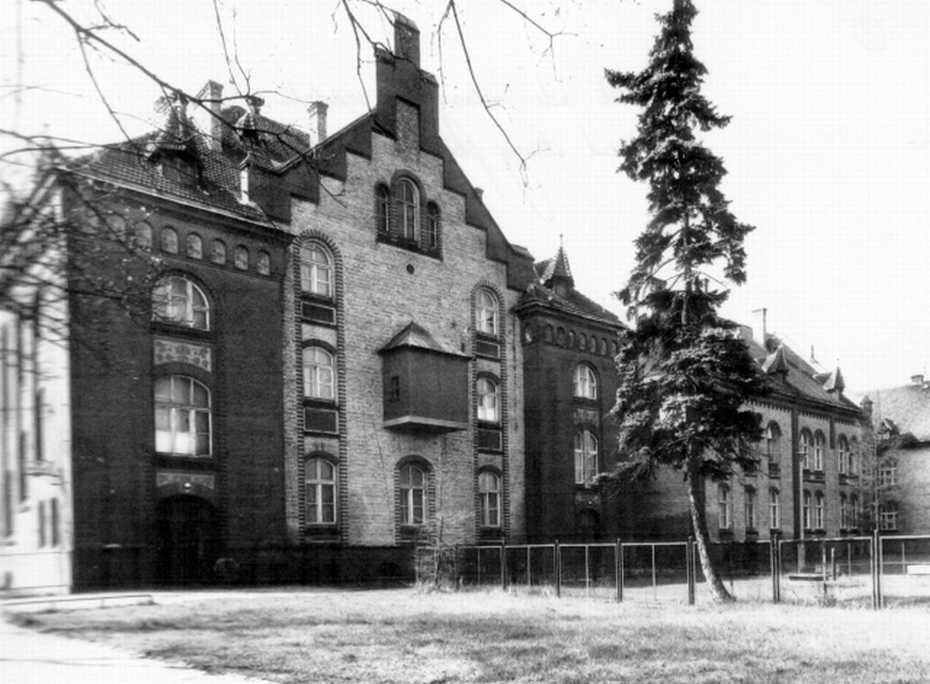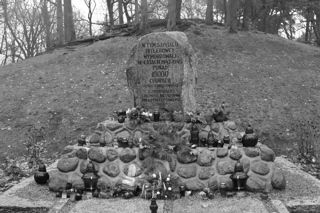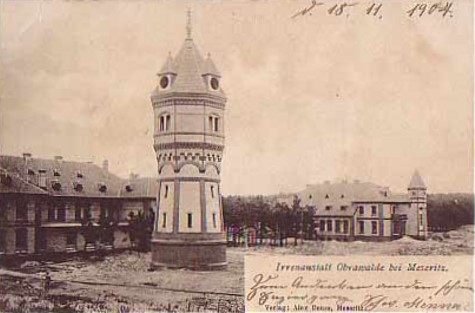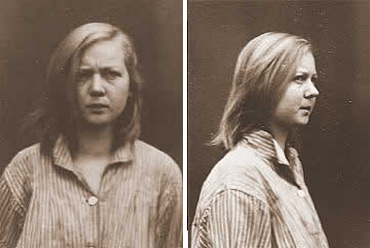Holocaust Education & Archive Research Team |
Euthanasia
Nazi Eugenics & Euthanasia T- 4 Staff T- 4 in Poland T - 4 in Germany & Austria | |||||
Meseritz-Obrawalde Euthanasia Centre
In 1939, the town of Meseritz was within the Prussian province of Pomerania. Today the town bears the name Miedzyrzecz and is situated in Poland. The hospital at Obrawalde (now Obrzyce), usually referred to as Meseritz-Obrawalde, together with the institution at Tiegenhof (now Dziekanka) in the Wartheland, were probably the most notorious killing centres of "wild" euthanasia.
During the period preceding the suspension of the euthanasia programme in August 1941, large numbers of patients had been transferred from Meseritz-Obrawalde "to the East" and had, like patients from other Pomeranian institutions, simply disappeared. At the beginning of 1942, the first trains, each containing about 700 handicapped patients arrived. They were eventually to be transported to Meseritz-Obrawalde from at least twenty-six German cities, usually in the middle of the night. At the end of the year, and especially in 1943, these trains arrived more and more frequently. All the nurses and orderlies - according to their statements - had to "unload" the patients. The sick patients were in horrible condition: many were emaciated and they were very dirty. This condition contributed to the nursing personnel being able to distance themselves emotionally from these people. The patients were in such an undignified condition that the personnel could be convinced to kill thousands of them without compunction. The staff selected for killing those patients who were unable to work, but the process was arbitrary and those selected included "patients who caused extra work for the nurses, those who were deaf-mute, ill, obstructive, or undisciplined, and anyone else who was simply annoying" as well as patients "who had fled and were recaptured, and those engaging in undesirable sexual liaisons."
Meseritz-Obrawalde Today The selected handicapped victims were taken to so-called killing rooms where physicians and nurses killed them using an orally administered drug overdose or a lethal injection. The killing of was never done by only one nurse. Practical experience had shown that it was absolutely necessary for the killing to be done by at least two nurses. After the patient had been killed by the male and female nurses, a fraudulent death certificate was prepared and sent to the victim’s family. Most of the naked corpses were buried in mass graves, but some were cremated in Frankfurt an der Oder. Construction of a crematorium to handle the large number of corpses was begun, but the project was not yet completed when Soviet troops liberated the hospital on 29 January 1945. Meseritz-Obrawalde had 900 patients in 1939, but during the war the institution was filled to capacity with 2,000 patients.
The exact number of patients killed will never be known since only a portion of the institutional records survived, but even the most conservative estimate of 6,991 patients killed exceeds more than three times the hospital's maximum occupancy. A less conservative but probably more accurate estimate by the post-war German judiciary placed the number of handicapped patients killed at Meseritz-Obrawalde at more than 10,000. Some sources suggest as many as 18,000 victims. There is also some evidence that physically or mentally impaired German soldiers were included in that number. Several thousand unused urns found at the time of liberation indicate that many further murders were planned. Testifying after the war to the Polish commission investigating the crimes committed at Meseritz-Obrawalde, former patients told of terrible conditions that included features also common to concentration camp life, such as roll call (Appell), forced labour, selections, and the use of inmate trustees similar to the inmate functionaries in the camps. In 1965, a trial was held in Munich of fourteen female nurses who had served at Meseritz-Obrawalde. They were accused of “cooperation with the 'Euthanasia Program' by killing thousands of mentally disabled patients through the administering of overdoses of Veronal or Luminal, or by injections with Morphia-Scopolamin or plain air, respectively.” Their testimony provides an insight into the ease with which, given suitable social and political circumstances, it is possible to convince healers to become killers. How much easier was it to convince the non-medical personnel of Aktion Reinhard to kill on a vastly greater scale? Helene Wieczorek [accused of killing 'several hundred' patients]: “Director Grabowski told us we had to help the senior nurses - it was too much for them. We would also have to give the injections. At first I refused and he said that there was no point in my doing so because, being a civil servant of many years standing, I had to perform my duty, especially in times of war. He added that there would be a law stating that the incurable mentally ill persons were to be released from their suffering… I only did my duty and I did everything on the orders of my superiors. Director Grabowski always warned us of the Gestapo. He said he would inform the Gestapo if we didn't do what he ordered.” Luise Erdmann. [the main defendant in the trial, accused of participation in the killing of 210 patients]: “Through the behaviour of Dr. Wernicke I realized that incurable patients were to be released by giving them Veronal or another medicine. I also declare that was I was not informed by Dr. Wernicke or any other person at the home about euthanasia. I wasn't sworn to secrecy in this respect... I was of the opinion it was taken for granted or believed that I would approve of euthanasia. My attitude to euthanasia was, should I become incurably ill - I don't make any distinction between mental or physical illness - I would consider it as a release if a physician or, on the direction of a physician, another person, would give me a dose releasing me from everything. Despite my attitude to euthanasia, I have - when confronted with the problem - fought out serious inner conflicts. Euthanasia, in the form I experienced it at that time, was after all, a killing of people and I asked myself if a legislator had the right at all to order or permit the killing of people. Never, however, did I hear about a corresponding law on the use of euthanasia but, on the other hand, Dr. Mootz explained to me once that there was no need for reservation as, should the situation arise, he would cover up for me. From this statement I concluded that there had to be some legality for euthanasia.”
Erna Elfriede E. [accused of participation in the killing of 200 patients]: “They didn't make me swear about a secret matter of the Reich and I wasn't sworn to silence.... I considered the killings as injustice. Something like that was not supposed to happen, because nobody was allowed to order it. I was brought up as a Christian. I already learned as a child what one may and may not do. I learned that one mustn't steal and mustn't kill.” When asked why she didn't refuse to participate in the killings, she replied: “Because I was ordered to do it. When I am asked again, why I didn't refuse, although I realized that it was an injustice, I can't give an answer to this question. I do and did in the past have a strong feeling of guilt but it is impossible for me to give a reason for the fact that I didn't refuse. It simply was ordered and I had to execute the orders.” All fourteen women accused in the Munchner Schwesternprozess (Nurses' Trial in Munich), were found not guilty of acting as an accessory to murder. Sources: Friedlander, Henry. The Origins of Nazi Genocide: From Euthanasia to the Final Solution, Unv. of North Carolina Press, Chapel Hill, 1995. Lifton, Robert Jay. The Nazi Doctors – Medical Killing and the Psychology of Genocide, Papermac, London, 1990. http://www3.sympatico.ca/mighty1/essays/nurses5.htm http://www1.jur.uva.nl/junsv/brd/brdengfiles/brdeng587.htm
Copyright: WAG H.E.A.R.T 2007
|





